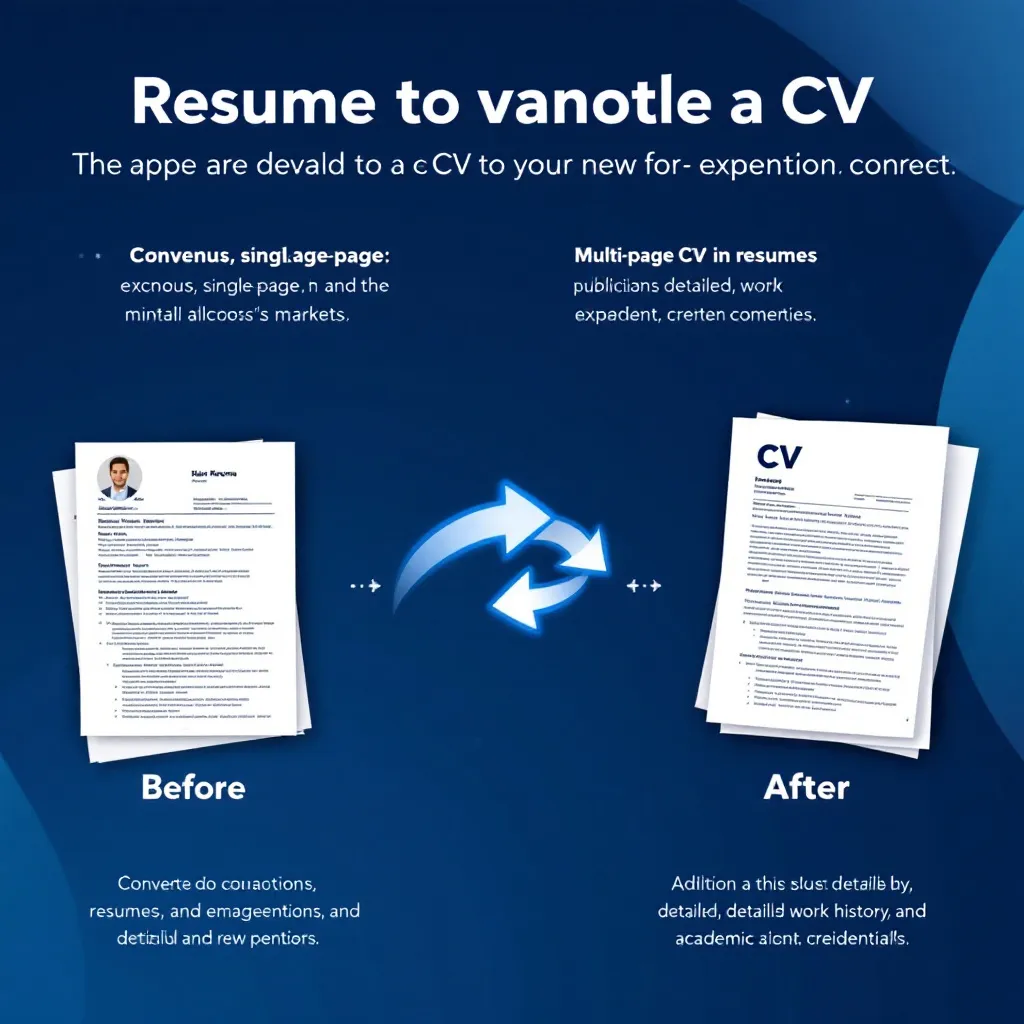In the U.S. job market, understanding when to use a resume versus a Curriculum Vitae (CV) can significantly impact your job search success. While most American employers request resumes, certain fields require the more comprehensive CV format. If you’re transitioning to academia, research, or international positions, knowing how to convert your resume to a CV is an essential skill.
Understanding the Differences: Resume vs. CV
Before diving into the conversion process, it’s crucial to understand the fundamental differences between these two document types:
-
Length and Focus: Resumes are concise (1-2 pages) summaries focused on relevant work experience and skills, while CVs are comprehensive documents that can span multiple pages, detailing your entire academic and professional history.
-
Content Scope: According to the Yale Office of Career Strategy, resumes emphasize skills and achievements in the private sector, whereas CVs detail publications, grants, teaching experience, and research projects.
-
Language Style: Resumes typically use action verbs (e.g., “managed,” “developed”), while CVs often prioritize nouns and titles (e.g., “Research Assistant,” “Principal Investigator”).
As noted by Harvard’s GSAS Guide, CVs are standard for academic, scientific, and research positions, while resumes are preferred for most business and industry roles in the United States.
When and Why to Convert Your Resume to a CV
You might need to convert your resume to a CV when:
-
Pursuing Academic Opportunities: Faculty positions, postdoctoral fellowships, research roles, and academic grants typically require CVs.
-
Applying Internationally: Some countries use the term “CV” for what Americans call a resume, and international organizations may request the more detailed format.
-
Transitioning to Specialized Fields: Medicine, scientific research, and certain humanities positions often require the comprehensive documentation that a CV provides.
Indeed’s CV Format Guide confirms that CVs are particularly important when your publications, presentations, and research experience are significant qualifications for the position.
Step-by-Step Conversion Process
1. Expand Your Professional Experience
Begin by transforming your concise resume bullet points into detailed descriptions:
- Add Specificity: Include methodologies, technologies, and theoretical approaches used in each role.
- Quantify Results: Maintain metrics from your resume but provide additional context.
- Include All Relevant Positions: Unlike with a resume template where you might omit older positions, a CV typically includes your comprehensive work history.
For example, a resume bullet point like “Managed team of 5 researchers” might become “Served as Project Manager for interdisciplinary research team of 5 specialists, overseeing methodology development, IRB approval process, and implementation of longitudinal study design.”
2. Adding CV-Specific Sections
According to MyCVCreator’s Guide, you’ll need to create several new sections not typically found on american resume format samples:
- Publications: List all published works using the appropriate citation style for your field (APA, MLA, Chicago, etc.)
- Presentations: Include conferences, workshops, and invited talks
- Research Experience: Detail lab work, fieldwork, and research methodologies
- Teaching Experience: List courses taught, guest lectures, and teaching assistantships
- Grants and Fellowships: Include funding amounts when appropriate
- Professional Memberships: List all relevant academic and professional associations
3. Restructure Content Hierarchy
Unlike resume formatting which prioritizes recent work experience, CVs typically place greater emphasis on:
- Education and academic credentials
- Research experience and publications
- Teaching experience
- Grants, fellowships, and awards
- Professional service (committees, reviewing, etc.)
- Non-academic work experience (if relevant to your field)
Tailoring Your CV for Different Contexts
The Harvard CV Guide emphasizes that CVs should be tailored to specific disciplines and purposes:
- Academic Disciplines: Humanities CVs often highlight teaching experience, while STEM fields emphasize research, publications, and technical skills.
- Career Stage Considerations: Early-career professionals might include more detailed coursework and academic projects, while senior academics focus on publications and grants.
- International Adaptations: Be aware that CV expectations vary by country. European CVs often include personal information that would be inappropriate on American documents.
If you’re uncertain about specific formatting expectations, reviewing resume examples from your target field can provide guidance, though you’ll need to expand these considerably for CV format.
Common Challenges and Solutions
Managing Length While Maintaining Relevance
Unlike cool looking resumes that prioritize concise design, CVs favor comprehensive content over brevity. However, every included item should still serve a purpose:
- Prioritize Recent and Relevant: While CVs are comprehensive, give more detail to recent and relevant experiences.
- Use Appendices When Necessary: For extensive publication lists or presentations, consider creating appendices.
- Maintain Consistent Formatting: Use consistent headers, fonts, and spacing throughout the document to enhance readability of longer content.
Addressing Experience Gaps
When changing resume to curriculum vitae, gaps become more apparent due to the comprehensive chronological nature of CVs:
- Include Professional Development: List relevant courses, certifications, and self-directed learning during employment gaps.
- Highlight Transferable Skills: Similar to accounting experience examples, frame non-academic experience in terms of research, analysis, or other transferable skills.
- Consider a Skills-Based Section: For career changers, a skills section can highlight relevant capabilities developed across various contexts.
Digital Tools and Resources for CV Conversion
Several resources can assist with the resume to CV conversion process:
- Academic Institution Resources: Many universities offer CV templates and guides through their career services offices.
- Field-Specific Examples: Professional associations often provide CV samples for their disciplines.
- ATS Optimization Tools: Systems like JobScan can help ensure your CV contains relevant keywords for academic job applications.
For creative fields, art resume template resources can provide inspiration for formatting, though academic CVs typically use more conservative designs.
Final Considerations
Converting a resume to a CV requires more than simply adding pages—it involves a fundamental shift in how you present your professional narrative. While resumes sell your fit for a specific role, CVs document your academic and professional journey comprehensively.
For students, free student resume templates can provide a starting point, but remember that CV conventions differ significantly from resume standards.
By understanding the distinct purposes and audiences for each document type, you can effectively transform your concise resume into a comprehensive CV that showcases your academic and professional accomplishments in their entirety.
ResuFit offers specialized tools to help with this transition, providing AI-powered assistance to expand your professional documents appropriately for academic and research contexts. Their document analysis features can identify gaps in your current resume that should be addressed when creating a comprehensive CV.

